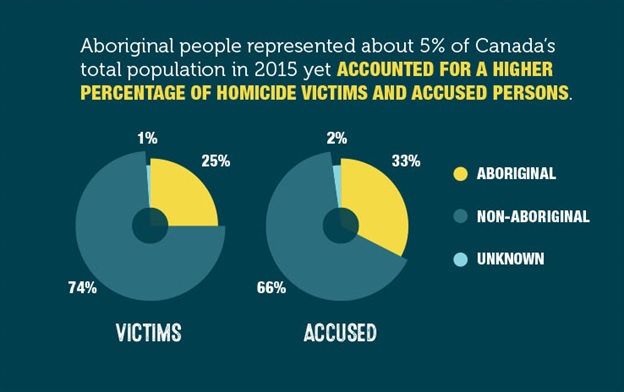By the numbers: Homicide rates in Waterloo Region
Homicide rates rose in 2015 in Canada, Ontario, and Kitchener-Cambridge-Waterloo census metropolitan area (CMA).[1] It will remain to be seen over the next few years whether this represents a notable change or simply reflhttp://ftn#1ects year-to-year variations in rates. Nonetheless, homicide rates in both Ontario and the Kitchener-Cambridge-Waterloo CMA continue to be below the national average, and Canada’s homicide rate has been dropping overall since 1975. What we do see is that homicide continues to impact some groups more than others, including Aboriginals, males, and those living in the Prairie Provinces.
The homicide rate in Canada rose in 2015 by 15%, reaching its highest levels since 2011. In 2014, there were 521 homicides, while in 2015, there were 604, increasing the homicide rate per 100,000 Canadians from 1.47 to 1.68.[2], which is still 2% lower than the average rate for the ten-year period between 2005 and 2014.[3]
Ontario also saw an increase in the homicide rate from 1.14 to 1.26. The Kitchener-Cambridge-Waterloo CMA also saw an increase in homicides from 3 to 6, with a corresponding increase in the homicide rate from 0.56 to 1.11, but these numbers are more variable because of the lower number of homicides.
Homicides in Canada, 1964-2015:
What has changed
2015 saw increases in homicide both involving firearms and involving gang violence. In Canada in 2014, 155 homicides were committed with a firearm, compared to 178 in 2015, an increase of 15%, and the highest number since 2008. Gang-related homicides also increased from 82 in 2014 to 98 in 2015, an increase of 20%, and the highest number of gang-related homicides since 2011.
The number of homicides increased primarily in three provinces: Ontario, which had 18 more homicides for a local increase of 23%; Alberta, which had 27 more homicides for a local increase of 25%; and Saskatchewan, which had 19 more homicides for an increase of 79%.
However, not all changes in homicide rates were increases.
- Homicides by strangers dropped by 21% from 73 to 58 between 2014 and 2015. Conversely, 87% of victims knew those accused of their homicides.
- Intimate-partner homicides remained relatively stable, with 83 such homicides in 2015 compared with 80 such homicides in 2014.
Continuing Patterns
Homicide continues to affect certain portions of the population and certain parts of Canada more than others.
- Homicide continues to disproportionately involve Aboriginal Canadians, with 25% of homicide victims and 33% of those accused of homicide being Aboriginal, though Aboriginals make up only 5% of the population.
Homicides among Aboriginal people in Canada:

Source: Modified from http://www.statcan.gc.ca/pub/11-627-m/11-627-m2016008-eng.htm
- Males continue to be over-represented when it comes to homicide, accounting for 71% of homicide victims and 88% of those accused of homicide.
- Homicide continues to be overly prominent in the Prairie Provinces, for all of which homicide rates are now over 3 per 100,000, with Saskatchewan’s and Manitoba’s rates being more than double the national average.
Putting It All Together
Homicide provides a significant cost to Canadian society. According to a research report by Public Safety Canada, each homicide costs Canadians between $4.8 and $5.9 million.[4] These costs, along with the human costs of homicide, provide important incentives for monitoring and reducing the number of homicides in Canada.
Though homicide rates increased between 2014, it is difficult to say what this means. There have been similar spikes before, such as in 2011, when the rate spiked by 8% only to drop by over 10% the next year. Ontario witnessed a similar spike and drop between 2005 and 2006. In regard to the Kitchener-Cambridge-Waterloo CMA, because there are so few homicides, the homicide rate is likely to vary from year to year, with 8 homicides in 2013, then 3 in 2014 and 6 in 2015. It would take several years of higher rates before any continuing pattern could be identified. Nonetheless, the homicide rate in Ontario of 1.26 per 100,000 remains below the national average of 1.68, as does the homicide rate in the Kitchener-Cambridge-Waterloo CMA at 1.11 per 100,000. Overall, homicide has been on a decline since a national high of 3.02 in 1975. What we do see is that homicide continues to impact some groups and areas more than others, including Aboriginals, men, and the Prairie Provinces.
[1] The Kitchener-Cambridge-Waterloo census metropolitan is the Region of Waterloo excluding the Township of Wellesley and the Township of Wilmot
[2] Unless otherwise noted, all statistics are derived from Mulligan, L., Axford, M., and Solecki, A. (2016). Homicide in Canada: 2015. Ottawa: Statistics Canada. Retrieved on January 16, 2017 from http://www.statcan.gc.ca/pub/85-002-x/2016001/article/14668-eng.pdf.
[3] Statistics Canada. (2016). Homicide in Canada: 2015 [fact sheet]. Ottawa: Statistics Canada. Retrieved on January 25, 2017 from http://www.statcan.gc.ca/pub/11-627-m/11-627-m2016008-eng.htm.
[4] Gabor, T. (2015). Costs of Crime and Criminal Justice Responses. Public Safety Canada. Retrieved on January 16, 2017 from http://www.statcan.gc.ca/pub/85-002-x/2016001/article/14668-eng.pdf, p. 6.
Author: Daniel is an MSW student with the Waterloo Region Crime Prevention Council working on various research projects and community engagement initiatives. Daniel holds a doctorate in philosophy from the University of Toronto, where he taught for six years. He now runs a mediation and psychotherapy practice in downtown Kitchener while completing a master of social work degree at Wilfrid Laurier University.

